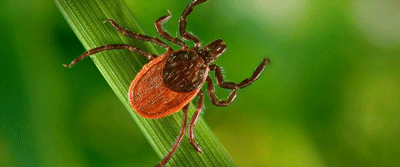In its most recent report, the Centers for Disease Control and Prevention revealed that in 2017 there were 1,997 confirmed cases of Lyme disease in Maryland, with an additional 697 probable cases. Left untreated, the disease can cause joint swelling and cardiac or neurologic complications.
With Lyme Disease Awareness Month in full swing, Ehrlich Pest Control officials say it’s important to note that with the mild spring Baltimore has experienced, there is a good chance of an extended tick season.
“When you have an early start to spring and warm weather, tick eggs will hatch sooner. The nymphs and adults will become active earlier, so you could have a prolonged tick season as a result,” said Chad Gore, who holds a Ph.D. in entomology and serves as the Market Technical Director with Ehrlich Pest Control.
“The longer the season, the more opportunities people have to be exposed to a tick that could be carrying bacteria that causes Lyme disease,” said Gore, who also volunteers as a technical advisor to the Pennsylvania Pest Management Association. “If you find a tick on you, remove it as soon as possible … it takes quite a long time for the Lyme bacteria to make it into the tick’s saliva and into your bloodstream so the sooner you can get the tick off of you, the better.”
Gore added that the most effective protective actions one can take against ticks are to wear an insect repellent containing DEET when spending time outdoors, even in your own yard. He says it’s important to wear long-sleeved shirts, long pants, and socks when working in a yard, hiking, or in wooded areas.
“After being outside, do a head-to-toe check for ticks. Adults should also do this check on children,” Gore said. “Check your pets for ticks regularly, especially if they spend a lot of time outdoors and speak to your veterinarian about proactive tick protection for your pet.”
Experts at Ehrlich recommend barrier treatments in yards, especially those in areas susceptible to tick activity. Barrier treatments include the application of a low-impact product to vegetation around the perimeter of a yard to kill ticks. These treatments should be repeated multiple times throughout the tick season to remain effective.
If someone encounters a tick, it’s also helpful to know how to remove it. For that, Gore suggested the following:
- •Use tweezers and grab the tick as close as possible to where it is attached to the skin.
- •Steadily pull upward and avoid twisting the tick. Twisting may cause the tick to break.
- •Rather than flushing the tick right away, it is best to submerge the tick in rubbing alcohol and save it for a week or two in case you need to see a doctor or veterinarian.
- •Save the tick in a plastic Ziploc bag or vial.
“If the thought of having the tick around really freaks you out, take a clear photo of the tick, being sure to capture a photo of both the back and underside of the tick,” Gore said. “This will help a doctor identify what type of tick bit you. Then, flush it to dispose of it safely.”
